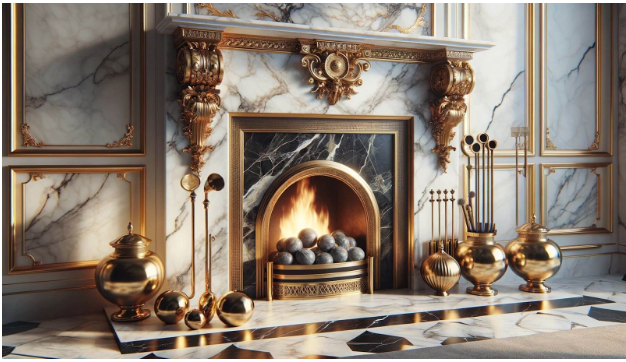Although fireplaces are no longer essential heating sources in many homes, antique fireplaces continue to bring unmatched elegance and historic allure to modern interiors. Their influence is seen not only in the grandeur of classic homes across the UK but in urban settings, like London, where the demand for these pieces has surged in recent years.
The Historical Roots of Antique Fireplaces
To appreciate how antique fireplaces shaped interiors, we also reached out to an antique fireplaces specialist from Thornhill Galleries, who explained, “Antique fireplaces are enduring symbols of artistry and tradition. Each one tells a story, blending craftsmanship with the history of its time, and provides a focal point that few other interior elements can match. Whether installed in period homes or used as a bold contrast in modern spaces, they evoke a sense of permanence and charm that’s impossible to replicate with contemporary designs.”
It’s also essential to understand their evolution. Fireplaces were originally crafted purely out of necessity, to warm homes and cook meals, with open hearths being common in the medieval period. These early fireplaces were simple stone constructions, yet they laid the groundwork for what would become intricate and highly stylized designs. As building techniques advanced, fireplaces became not only practical elements but also focal points around which rooms were designed. In castles, manor houses, and eventually middle-class homes, fireplaces grew in prominence, representing both warmth and wealth.
By the Georgian period, fireplaces had taken on a decorative role, with elaborate mantels and surrounds in materials like marble and stone becoming a fashionable choice. The era’s architectural preferences leaned towards symmetry, and fireplaces were designed to reflect this aesthetic, often aligned with other elements in the room. As architectural styles evolved, so did the fireplace, transitioning from grandiose to refined and sophisticated, and later, during the Victorian era, embracing more elaborate forms that echoed the ornamental tendencies of the time.
Craftsmanship and Artistic Expression
Antique fireplaces from the 18th and 19th centuries were often hand-carved by artisans, a testament to the skill and creativity of craftsmen. The materials used—marble, cast iron, wood, and stone—allowed for a variety of styles, from understated elegance to detailed ornamentation. In Georgian and Regency homes, marble fireplaces became particularly popular. The choice of marble not only offered durability but lent itself to the crisp, symmetrical lines and classical motifs characteristic of the period.
Victorian fireplaces, in contrast, often feature intricate patterns and floral motifs, inspired by Gothic and Rococo influences. These designs were often cast in iron, enabling mass production yet still maintaining a level of craftsmanship in each piece. Cast iron fireplaces became symbols of Victorian homes, representing the industrial era’s technological advancements while adhering to the high aesthetic standards of the time.
Each period’s design philosophies, from the refinement of Georgian symmetry to the ornate Victorian detail, left an indelible mark on antique fireplaces. The allure of these pieces today is partly due to the meticulous craftsmanship and artistic expression encapsulated in every fireplace, with each unique design reflecting the cultural and social context of its time.
Influence on Modern Interiors
In contemporary design, antique fireplaces continue to hold a revered place, often sought after to add character and depth to modern homes. While central heating has replaced fireplaces as the primary source of warmth in most British homes, the aesthetic and atmospheric value of an antique fireplace remains significant. In fact, there is an increasing trend in urban areas, especially in London, where antique fireplaces are being integrated into new developments and modern renovations. This fusion of old and new creates a juxtaposition that many designers and homeowners find appealing, bridging centuries of design philosophy in a single room.
Antique fireplaces in modern interiors serve as anchors, grounding the room with history and nostalgia while complementing contemporary furnishings and minimalist aesthetics. Homeowners who acquire antique fireplaces from reputable specialists like Thornhill Galleries often view these pieces as investments, appreciating both their intrinsic beauty and their potential to enhance property value. Moreover, antique fireplaces bring a sense of balance to modern interiors, tempering sleek lines and open spaces with classic, textured details.
Restoring and Reclaiming Antique Fireplaces
Preserving antique fireplaces requires a careful approach, as restoring such pieces can be intricate. Many older fireplaces have seen years of wear, and careful restoration is necessary to bring back their former glory while respecting their original materials and craftsmanship. Restoration specialists typically clean and repair surfaces, re-carve any damaged details, and ensure that the fireplace structure is sound. For some, finding an antique fireplace in salvageable condition and restoring it is a rewarding process that enhances the fireplace’s historical and sentimental value.
Reclaimed fireplaces have also become popular in sustainable interior design. By reclaiming and reusing antique fireplaces, homeowners and designers contribute to environmental conservation, reducing the need for new resources while preserving a piece of history. London has become a hub for reclaimed antique fireplaces, with many reputable dealers offering a selection that caters to diverse tastes, from simple Victorian cast-iron models to grand Georgian marble surrounds.
Placement and Integration in Contemporary Spaces
When incorporating an antique fireplace into a modern interior, placement is critical to achieving a harmonious look. Antique fireplaces were traditionally positioned as central features in formal living rooms or grand halls, but today, they are being used creatively in various settings. In open-plan designs, a fireplace can delineate spaces, creating a sense of intimacy within a larger area. In smaller urban homes or flats, fireplaces can serve as a decorative focal point, making the room appear larger and more welcoming.
In some cases, homeowners opt to integrate antique fireplaces in non-traditional spaces, such as bedrooms, kitchens, and even bathrooms, where they add unexpected charm. However, careful consideration should be given to balancing the antique piece with surrounding decor. Often, minimalist furniture, neutral colors, and modern materials work best to highlight the fireplace without overwhelming the room. For designers, antique fireplaces offer an opportunity to experiment with styles, balancing historical elegance with the sleek, uncluttered aesthetics favored in contemporary interiors.
The Role of Fireplaces in Creating Ambiance
Beyond their physical presence, antique fireplaces contribute significantly to a room’s ambiance. Few elements in interior design can match the warmth and charm that a traditional fireplace provides. In homes across the UK, antique fireplaces foster a sense of nostalgia, recalling times when families gathered around the fire as a social ritual. This emotional resonance is why many people seek out antique fireplaces, even when they are not used for heating.
With many antique fireplaces in London being converted to biofuel or electric options, homeowners can retain the look and feel of a traditional fireplace while accommodating modern energy standards. These conversions provide the visual appeal and warmth without the need for coal or wood, offering an eco-friendly alternative that suits today’s environmentally conscious society.
Practical Considerations for Antique Fireplaces
For those interested in installing an antique fireplace, there are several practical aspects to consider, particularly in regard to building regulations and safety requirements. In the UK, the installation of fireplaces must comply with local building codes, especially when involving flues, ventilation, and structural adjustments. Professionals can ensure that the fireplace fits seamlessly into the home and operates safely within modern standards.
Another consideration is the size and proportion of the fireplace relative to the room. Antique fireplaces come in a variety of sizes, and selecting one that is appropriately scaled for the space is crucial to achieving a cohesive design. Large, ornate fireplaces may overwhelm small rooms, while a more understated piece might not make enough of an impact in a spacious area.
Timeless Appeal in a Modern World
The renewed interest in antique fireplaces signifies more than just a trend; it reflects a broader appreciation for history, craftsmanship, and sustainable practices. Whether a stately Victorian model or a streamlined Regency piece, antique fireplaces bring an enduring charm to interiors that transcends changing design fads. As modern design continues to evolve, these pieces offer a comforting reminder of continuity, grounding contemporary spaces with touches of the past.
Homeowners and interior designers alike recognize that antique fireplaces are more than decorative features; they are enduring symbols of heritage and artistry. By choosing to incorporate these pieces into their homes, people are embracing not only a design statement but a legacy that has shaped British interiors for centuries.












